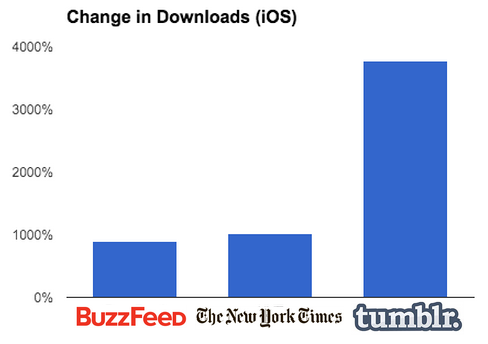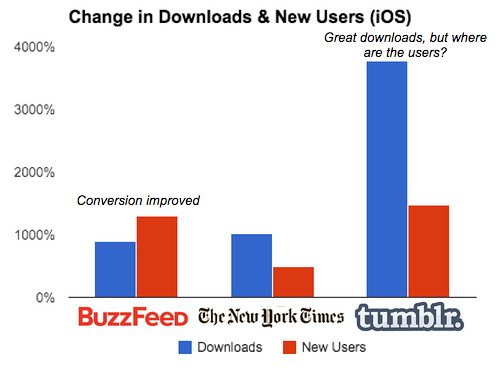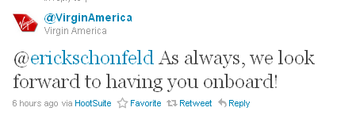|
Every start-up dreams about being mentioned in The New York Times. A dash of NY Times ink provides credibility to your idea and drives usage, or so the logic goes. But in today's rapidly changing media landscape, does this still hold true? Based on my experience with TalkTo, the answer is a resounding NO. In fact, even large websites like BuzzFeed may not provide a huge boost to your business. The holy grail of driving traffic: raving fans writing genuine reviews for a small but passionate readership. I came to this conclusion by comparing how press coverage from three outlets improved our average daily iOS downloads. I looked at daily downloads 5 days prior to each article and 5 days after each article. TalkTo, which was acquired by Path in June, has been covered by many of the major publications but for this study I looked at mentions in The New York Times (Old Media), BuzzFeed (New Media), and Tumblr (Social Media). A Tumblr blog posted by an angsty 20-something from Canada named HeyitsJnnfr increased downloads by a factor of 38; in other words, if we got 1 download prior to the blog, we got 38 the following week. Jennifer nailed a particular use-case: "people who suffer from social anxiety where telephone communications might be triggering or uncomfortable." This message resonated with her 2,500 followers who started to like and reblog the post. As of today, this obscure blog has been shared by 89,000 people. In comparison, BuzzFeed, with 1.41 million Twitter followers and 3.8 million Facebook likes, drove a 10X increase in downloads. The New York Times (13 million Twitter, 8.5 million Facebook) drove slightly more downloads than BuzzFeed and but far fewer than Heyitsjnnfr's post. Downloads are only half of the battle. The other key element is conversion, i.e. the number of people that download, open and use the app. In this metric, BuzzFeed was the best. As you can see from the chart below, the 5-day before/after change in BuzzFeed New Users outpaced downloads. Tumblr, on the other hand, was pretty abysmal: A 38X increase in new users only yielded a 16X increase in New Users. The New York Times was similar to Tumblr. Key Take Aways
6 Comments
My father-in-law Sam designs and builds custom kitchens in Vermont. Several years back, he established a website. The website did its job; it provided him a web presence that landed him a couple of jobs per year. In the past year or two, though, he has received fewer and fewer leads. "All I need to do is replace the jobs I use to get through the website and all will be well," he told me over a scotch below the Vermont moon. Below is a follow-up email I sent him explaining how the web has changed and what he needs to do as a small business owner to evolve. For most of my readers, this is pretty obvious stuff. For others, I hope it is enlightening.
* * The internet has evolved since you built your website five years ago. At that time, the internet was "search-centric," meaning people knew what they wanted and simply went to Google to search that topic. Obviously, this still exists; Google search is still extremely relevant. But the "search" era has evolved into the "discovery" era. In the discovery era, people start on a social network - namely Facebook and Twitter - and discover information posted by other people and companies. Let's use your business to illustrate the two eras. In the search era, a person seeking a new kitchen would go to Google and search for "custom kitchens in Vermont." The result would be a laundry list of potential vendors and maybe a few bloggers talking about the topic. Depending on your search engine optimization (SEO) strategy, your company may be at or near the top. The person would peruse the top five or six websites and winnow the list down to two or three companies to call or email. Hopefully, you're on that list. Fast forward to today. You're potential customers are definitely on Facebook and probably on Twitter. On Facebook, they are connected to friends, family members and maybe a few businesses. On Twitter, they are following people with similar interests. This may include high-profile chefs like Tom Colicchio (@tomcolicchio), local food businesses like Round Barn Farm (@roundbarnfarm) and the local news (@wcax). In this world, your potential customers are spending hours on their social network of choice and learning about new ideas and new products from people they trust. They may “discover” the benefits of a custom kitchen from a friend’s post or a chef’s tweet. So how do you evolve your business for today's internet? Simple: insert yourself and your company into the conversation. Start a blog A blog allows you to share your design philosophy and experiences with the world. A blog is not a sales tool, per se. Rather it is a tool that helps readers know you – and hopefully trust you. Once they do this they can be converted into customers. Creating a successful blog is difficult. Here are some tips that I have found helpful:
An active blog is of little value if no one is reading it. Thus, a key part of blogging is promotion. The first place to start is Twitter. Think of Twitter as the world’s largest user-generated headline service. Here is what you do. After you write a blog, tweet it out. Be sure to include a shortened link (use bit.ly). Also, tweets in the form of a question usually get the best response. So instead of “Check out our tips for storing compost” try “Do you know the best way to reduce waste and increase your garden’s performance?” Also, tweet at people and trends. Let’s say you write a blog about the local food movement and what it means for the home kitchen. This would obviously be of interest to people in the local food movement so you want to craft your tweet accordingly. You do this two ways:
Use Twitter to insert yourself into the conversation In addition to promoting blog posts, use Twitter to insert yourself into the conversations that matter to your business. The first step is following the same handles as your customers. These include people/organizations talking about your line of business (custom building), your local community (Vermont, Burlington, etc.) and parallel interests (local food, organic cooking, and ergonomic design). As you read these tweets you can simply retweet them to your followers; this is like a seal of approval. Or you can reply by including the persons @ handle. Lastly, and perhaps most importantly, use Twitter to share brief thoughts and insights. Let’s say you try and love a new cabinet roller. Well, take two minutes to tweet out your findings. Bringing it closer to home: Facebook Think of Twitter as a macro tool. Ideally, you will attract tens of thousands of followers located all across the world. Facebook, on the other hand, is more of a micro tool. On Facebook, you will set-up a page for your business. The primary purpose of this page is to connect with your customers. As you talk to customers, tell them you’re on Facebook and that they should “like” your page to stay updated. Use your page to post links to your blog, before and after photos of jobs, articles you find interesting, and other musings. In many ways, you are using the same content from Twitter but just in different format because you aren’t confined by 140 characters and you’re not using @ and #. Lastly, Facebook is where you should consider running advertisements. Facebook, more than any other media, is highly targeted. Using Facebook’s self-service tools, you can chose to deliver adds to UVM Professors living in the Burlington area that are under 45, like cooking and have showed interest in home renovation. It is that precise. In fact, there is a wives’ tale of a Facebook employee knowing his wife so well that he was able to narrow down the parameters and deliver her (and only her) to-do list items as ads. Obviously, a social media strategy is not an end-all-be-all. You still need to do what you do best, which is work referrals, partner with other builders in your area, etc. But it when it comes to the web, you definitely need to embrace these strategies so you can be "discovered." Earlier today, Erick Schonfeld was delayed by American Airlines. He took his frustration to Twitter, posting the following tweet. Within a few minutes, American Airlines responded to Erick's disparaging tweet. Makes sense. Erick is the editor of TechCrunch and followed by 31,000 people. In other words, Erick is an "influencer." Overall, AA's responses is an impressive example of how companies need to operate in the Web 2.0 age. However, Virgin America wins this battle. Virgin America proactively followed with the below tweet.
|
JONATHAN STEIMAN
I'm the Founder and CEO of Peak Support. This blog is my take on early-stage companies and innovation. Every so often, there may be a post about culture, networking, family -- you name it. After all, what is a blog if it isn't a tad bit unstructured.
Archives
December 2016
Categories
All
|





